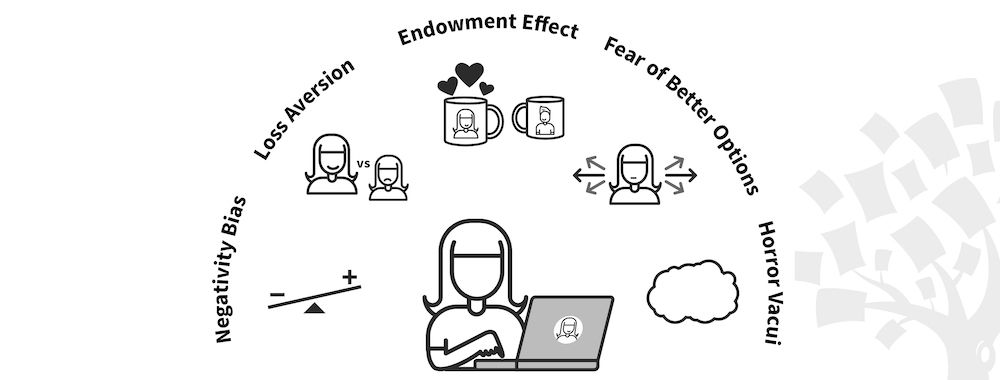Behavioral economics is a discipline examining how emotional, social and other factors affect human decision-making, which is not always rational. As users do not always have stable preferences or act in their best interests, designers can guide their decisions via strategic choice architecture—e.g., pricing structure.
See how a grasp of behavioral economics can help drive effective interventions in the following video by Big Think.
“Choose less and feel better.”
— Barry Schwartz, Psychologist and author
Behavioral Economics and the Power and Shortcomings of Human Choice
Before 20th-century advances in psychology and neuroscience, human thinking was typically deemed a rational process of analyzing situations logically to find optimal solutions. Behavioral economics turns that idea around and proves that humans can’t weigh up pros and cons so clinically. Psychologists Daniel Kahneman and Amos Tversky pioneered the field in the 1970s, isolating “cognitive illusions” that affect judgment and determining the human tendency to make irrational choices in the face of uncertainty. They found the potential value of losses and gains—not rational assessments of outcome—guides decision-making. This school of thought asserts the pain of loss is far more profound than the pleasure of gaining something equally valuable. Human thinking is naturally bounded by limitations in knowledge, processing ability and feedback; thus, designers should consider users’ aversion to thinking too much and frame selected options insightfully.
Fundamental to behavioral economics is that two thought systems are at work in people—one operates with intuitive, experience-based and relatively unconscious processes; the other involves controlled analytical processes and depends on a person’s cognitive ability, in-the-moment bias and influence from society. Using behavioral economics principles, designers present the right information (and right amount) to engage users and guide them towards desired calls to action.
![]()
Netflix uses defaults to help users select their desired subscription plan.
Behavioral Economics in the Challenge of Interaction Design
In user experience design, designers exploit a uniquely human fact—the brain is naturally a cognitive miser. It doesn’t like being flooded with information; so, the power of choice can be a strain. Complex decisions are taxing, even if users can take their time. Regardless of intelligence, they’ll seek simpler solutions and will subconsciously apply heuristics (judgmental shortcuts) to minimize effort. However rational users believe they are, they can be prompted to act in ways they might never expect. A common example is to leverage how people consider an item’s value in relative—not absolute—terms and lead them to buy a high-value product because it seems like a bargain compared with costlier ones.
When accessing unfamiliar content such as new interfaces, users will base decisions on value judgments and context. Therefore, to help users make choices that benefit themselves and the business, you should optimize the information architecture of your designs while carefully considering the ethical dimensions. The best design solutions always work in the users’ and provider’s best interests. A vital distinction is the difference between manipulating users and ethically applying principles of behavioral economics. Reputable e-commerce solutions exemplify the latter, including:
Framing—Drop the right anchor to set a frame of reference. Anchoring is a form of priming where the first number users see serves as a marker for judging other items’ values. As this first piece of information impacts users’ decision-making, you can prompt them to compare other offerings favorably against it by highlighting a more expensive item.
Defaulting—Give users the right defaults to help them decide what to do/buy. Limit choices to only those most appropriate for the step/category; typically, if you show users more than 4 options, they’ll start feeling overwhelmed. Regarding an item’s extra features, users will prefer a higher-priced baseline (to remove options from) over a lower-priced one (to add options to).
Reciprocation/Power of Free—Offer free items; it’s a guaranteed way to put goods in users’ hands, and it fosters obligations (e.g., “If you liked this article, please share it.”).
Streamlining—Remove obstacles from processes (e.g., Amazon’s one-click ordering feature); similarly, insert obstacles to discourage unwanted behavior.
Social proof—Make users feel they’ll be consumers of a popular item, which also usually bolsters their sense of security, as does the power of authority via expert/celebrity endorsement.
Attribute priming—Ask users what features they want, to help point them towards desired items.
Scarcity—Tap into the fear of loss and raise the value of limited items in users’ minds.
Salience—Appeal to customers with relevant add-ons before checkout.
Guard-railing—Keep users on track towards desired actions and make course-correction easy.
Tackling Loss Aversion—Word incentives to showcase potential gains and downplay negative outcomes (e.g., a 90% success rate sounds more attractive than a 10% failure rate).
You should present features to simplify the user experience and prevent information overload. Above all, frame options ethically to offer meaningful change through user-centered design and appropriate nudging towards desirable actions for all parties concerned.
![]()
WordPress’s home page uses social proof—by highlighting that a whopping 35% of the Internet is built on WordPress, it makes people trust the platform more.
![]()
Amazon’s checkout flow uses salience—when you purchase an external hard drive, it presents you with a data recovery add-on before you checkout.
Learn More about Behavioral Economics
Study behavioral economics in our course: https://www.interaction-design.org/courses/psychology-of-e-commerce-how-to-sell-online
Here’s an in-depth, example-rich article on persuasive design, including behavioral design elements: https://www.smashingmagazine.com/2018/07/persuasion-user-experience-design/
This insightful piece explores additional considerations concerning behavioral economics: https://uxmag.com/articles/how-to-help-your-users-take-action






